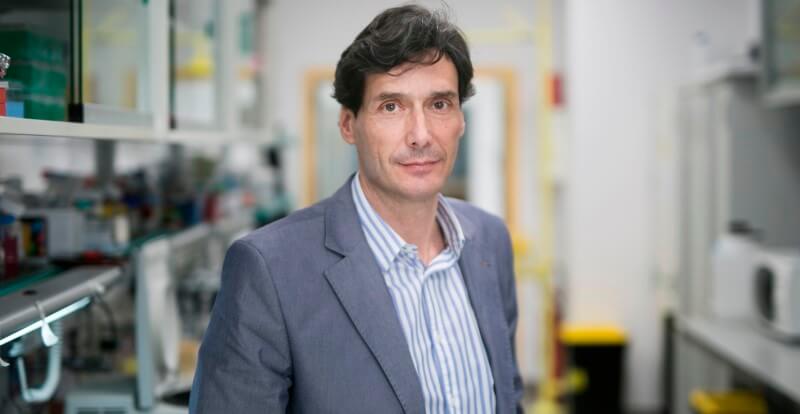
Manuel Serrano expands his pioneering research into regenerative medicine at IRB Barcelona
This morning, the scientist Manuel Serrano, the director of the Institute for Research in Biomedicine (IRB Barcelona) Joan J. Guinovart, the director of Research and Knowledge Section of the “la Caixa” Banking Foundation Jordi Portabella and the director of the Institució Catalana de Recerca i Estudis Avançats (ICREA) Antonio Huerta have presented the challenges in regenerative medicine that Serrano will tackle from his new Cellular Plasticity and Disease Lab at IRB Barcelona located at the Barcelona Science Park.
Manuel Serrano (born Madrid, 1964) comes to IRB Barcelona under an ICREA Research Professor contract from the Government of Catalonia and with funding from the “la Caixa” Banking Foundation, the latter will support the research undertaken by his lab, which comprises 14 scientists. “This support from public and private sectors is crucial as it will allow us to make a qualitative leap in our research,” said Serrano in a press conference held at IRB Barcelona, located at the Barcelona Science Park.
Jordi Portabella said, “One of our priorities is to foster talented senior researchers by providing them with everything they need to reach their full potential and to develop science of excellence in the centres in in Spain. This strategy thus strengthens cutting-edge research with the potential to benefit society”. Antonio Huerta commented, “ICREA is an organisation run by the Government of Catalonia that seeks to draw talent into our research system. Each year it brings outstanding scientists into the best universities and research centres in Catalonia. ICREA, an organization based on collaboration, has been operating for 15 years and has made this new recruitment possible”.
“IRB Barcelona boasts an outstanding scientific team which will now be strengthened with the recruitment of another ace,” said Joan J. Guinovart. “Research of excellence is only possible when supported by both competitive and philanthropic funding,” he added.
“Thirteen years at the Spanish National Cancer Research Centre (CNIO) has allowed me to mature as a scientist and the freedom I enjoyed there gave excellent results,” says Serrano. He explains that his interest “has moved from cancer to tissue repair and cell reprogramming”—fields linked to many disciplines—and that “the multidisciplinary context of IRB Barcelona brings an advantage to establish new collaborations.
Serrano considers Barcelona to be a major biomedical hub in Europe. “Flexible and dynamic research centres and a talent attraction programme like ICREA based on competence, scientific merit and creativity are the two key components for a solid research system. If we add to this the growing support of private foundations such as “la Caixa”, the momentum will be even greater”. With Manuel Serrano’s group, IRB Barcelona now has 25 laboratories, three of which have been set up in the last six months.
Reprogramming, repairing, and regenerating
Defective repair processes are at the root of many diseases, such as cancer, and cell aging. The research done in Serrano’s lab aims to unravel how tissue damage is repaired and clarify the link between cell reprogramming and repair. “It is a field about which little is known and in which we have an advantage that we wish to exploit,” says the researcher. In 2013 Serrano published a scientific breakthrough in Nature in which he successfully reprogrammed cells for the first time within a living organism. In 2016 he published an article in Science in which he demonstrated that tissue damage is a relevant factor for cells to return to a state that is similar to the embryonic one. Both findings, together with previous breakthroughs in oncology, have established him as an international authority in biomedicine.
Serrano and his team are working on two very different diseases with the aim to further regenerative medicine. The first is lung fibrosis, a rare degenerative condition that has no cure. The second is diabetes, which is highly prevalent and for which chronic treatments are available. “In diabetes, the insulin-producing cells in the pancreas are damaged and the goal is to get the pancreas to regenerate these cells,” he says.
First spinoff
Serrano has taken steps to bring the benefits of his discoveries closer to patients with lung fibrosis. In parallel to setting up his new lab, he has cofounded, together with three colleagues, his first biotech spinoff, which is currently located on the same premises as IRB Barcelona, at the Barcelona Science Park.
Called Senolytic Therapeutics, the spinoff will develop future clinical trials of a drug developed and patented by the group and that selectively kills damaged lung cells and improves lung fibrosis. The drug candidates have shown to be effective in mice. “In the case of a rare disease for which there is no efficient treatment, even a small improvement can be considered a success because it can bring about a significant increase in the quality of patients’ lives,” explains the researcher. “We will also produce new compounds with the potential to treat lung fibrosis and similar diseases,” Serrano explains.




